Youth in Crisis: How Kings County Locks Up Youth With Disabilities

Youth in Crisis: How Kings County Locks Up Youth With Disabilities
Disability Rights California (DRC) recently learned through media reports that Sacramento County is housing foster youth at the Warren E. Thornton Youth Center (“WET Center”), an unlicensed juvenile facility formerly operated by Sacramento County Probation. In response, DRC’s Investigations Unit opened an investigation into the facility and conducted an unannounced site inspection on April 17, 2023.
Youth in Crisis How Kings County Locks Up Youth With Disabilities
Introduction
Disability Rights California and Disability Rights Advocates conducted a multi-year investigation into conditions at the Kings County Juvenile Center. This locked youth detention center is in Hanford, California and houses between 20 and 30 youth who are detained or incarcerated. We were assisted in our investigation by two nationally recognized experts on juvenile criminal justice and education in secure juvenile justice facilities. This report documents our findings. We provided these findings to the County in September 2022, but since then, the County has refused to offer a meaningful response or even agree to a meeting.
Our investigation revealed that the County’s youth arrest and detention rates are excessive – among the highest per capita in the state by several measures. The County lacks any diversion program and detains youth who pose little risk, including for status offenses1 such as truancy. With few re-entry supports, youth are repeatedly re-detained for minor probation violations, throwing them into a vicious cycle that disrupts their education and employment. Youth with disabilities are held in the Kings County Juvenile Center for disability-related behavior that could have been addressed by County staff more effectively in the community at less cost. Mental health services for youth are inadequate, both in the facility and in the community.
Second, the youth detention center is prison-like and regimented, rather than the homelike, rehabilitative environment that state law requires. Youth are routinely pepper sprayed in their cells, day rooms and classrooms, often in their face and eyes. For minor infractions, youth are shackled and “body-slammed” by custody officers or forced to sit alone in hallways for hours at a time. Young people with mental health and behavioral disabilities are disproportionately subject to these practices, which lead to serial discipline, court reports and extensions of their length of stay. Organized activities and outdoor exercise are limited, so youth endure forced idleness, or at best, hours of watching TV in the dayrooms. The incentive program is frustrating and confusing, especially for disabled youth. These conditions re-traumatize many youth with a history of trauma held at the facility.
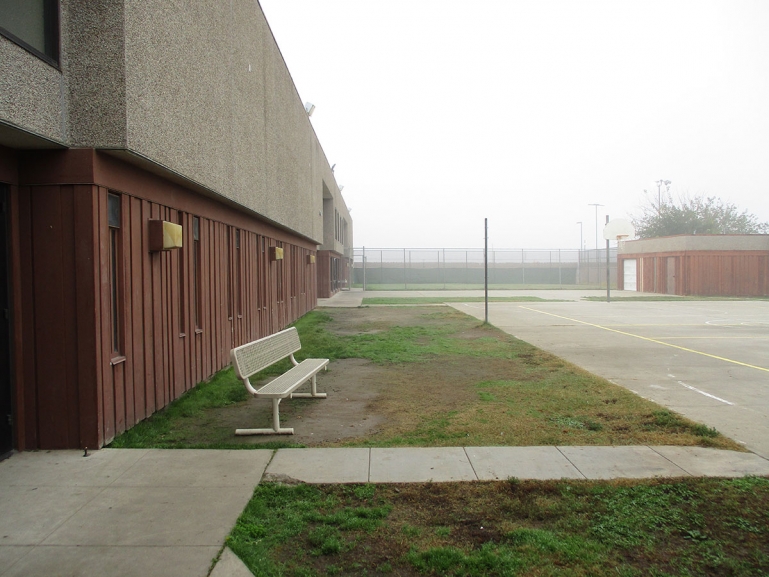 Photo: The exterior of the detention center.
Photo: The exterior of the detention center.Third, Probation staff in tactical gear improperly interfere in the J.C. Montgomery school at the detention facility, monitoring students’ work and behavior without regard to students’ special education accommodations. Unlike most other youth facilities, Probation, mental health and school staff have no regular process to review incident reports, discuss the needs of various youth, and coordinate supports to disabled youth.
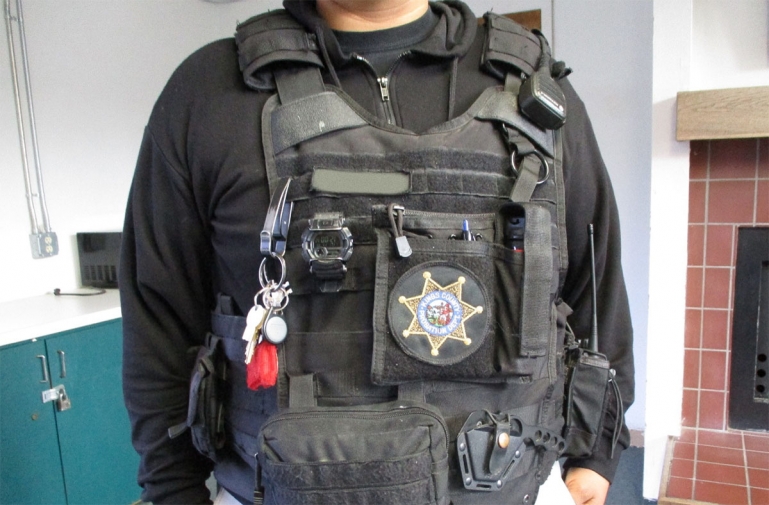 Photo: Probation staff wear tactical vests.
Photo: Probation staff wear tactical vests.

In July 2023, we learned that the Board of State and Community Corrections’ (“BSCC”) also made findings that corroborate the issues that our experts identified last year. The BSCC report called out excessive use of pepper spray, unlawful use of solitary confinement, and inadequate programming and counseling services, just as our experts did. Many of the BSCC’s findings were repeat concerns. In its 2021 inspection report, the BSCC found that youth in crisis spent days in solitary confinement due to the lack of on-site mental health staff. At the time, the Center had just two mental health clinicians that it shared with the 600-bed Kings County Jail next door.
Federal and state law prohibit discrimination against youth with disabilities. The practices described below violate the Constitutions of the United States and California, Americans with Disabilities Act, 42 U.S.C. § 12101, et. seq., Section 504 of the Rehabilitation Act of 1973, 29 U.S.C. § 794, and Cal. Gov’t Code § 11135, among other authorities. These conditions cannot be allowed to continue.
We encourage Kings County to resolve these problems, reform conditions in the detention center, and stop the revolving door that returns too many youth to secure detention for non-violent offenses. It can do so by implementing the following nine recommendations:
Recommendations
Kings County Probation Department
- Reduce the excessive use of force by re-training Probation staff to act as counselors rather than merely guards;
- Eliminate the use of pepper spray by first placing sharp limits on its use;
- Reform the discipline system;
- Convene weekly meetings between Probation, its mental health contractor and school staff to address the needs of individual youth with disabilities and reduce their disproportionate discipline;
- Reduce the excessive youth detention rate by funding independently run, community-based diversion programs and investing in defense-based advocacy;
- Reduce recidivism by expanding re-entry services and coordinating with the County Office of Education to support youth with school problems;
- Discourage arrests for status offenses and do not detain youth for non-violent offenses, including violation of probation;
- Eliminate the involvement of Probation staff in school discipline.
Kings County Behavioral Health System
- Expand community-based mental health and much-needed drug treatment for youth, including by providing crisis intervention and stabilization without law enforcement involvement.
Report on the Kings County Juvenile Center
Background
Kings County is in California’s Central Valley, with a population of 155,000. The County Probation Department operates the Kings County Juvenile Center (KCJC), a 65-bed complex with two classrooms and three living areas, divided by security level. The County has received state funds for a new facility but will continue to house youth in the existing facility and operate both together. Approximately 20 to 30 youth are housed in the facility at any time. Disability Rights California and Disability Rights Advocates began this investigation in 2019 after receiving complaints about conditions there.
We retained two nationally recognized experts: the Center on Juvenile and Criminal Justice (“CJCJ”) and Dr. Peter Leone. CJCJ is a nonprofit nonpartisan organization that has provided technical assistance and policy analysis for over three decades.2 CJCJ partners with national, state, and local jurisdictions as well as nonprofit and advocacy organizations to promote a balanced and humane criminal justice system designed to reduce incarceration and enhance long-term public safety. CJCJ conducts data-driven research and policy analysis promoting effective approaches to criminal and juvenile justice policies. In providing analysis for us, CJCJ analyzed publicly available data, Kings County documents obtained through our investigation and conducted interviews with Probation Department staff and incarcerated youth in Kings County facilities. Their analysis sheds a critical light on the practices of the Probation Department.


Dr. Peter Leone is one of the most respected national experts on education in secure juvenile justice facilities. The County Office of Education, in conjunction with Probation, provides education services to youth in the detention center at the on-site J.C. Montgomery School. Dr. Leone participated in this investigation, inspected the facility and school, interviewed staff, youth and their families and reviewed extensive documents. He concluded that Probation staff improperly interfered at J.C. Montgomery School.
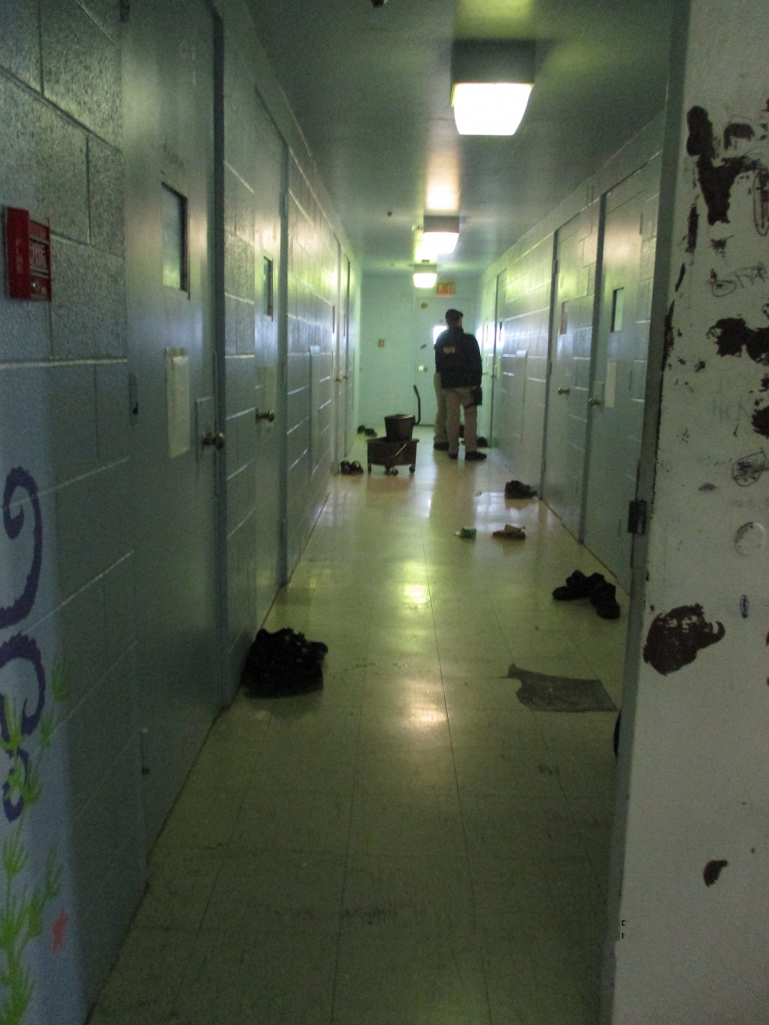 Photo: A hallway at KCJC.
Photo: A hallway at KCJC.BSCC Inspections of the Facility
Our findings are consistent with the result of inspections by the California Board of State and Community Corrections (BSCC). This state agency conducts biennial inspections of county juvenile detention facilities to determine compliance with state licensing requirements. In its 2021 report, BSCC found that the detention center did not have sufficient mental health staff to respond to youth in crisis. Youth on suicide watch were placed in solitary confinement until a mental health clinician could respond, which often took more than 24 hours. At the time, the Facility shared just two clinicians with the 600-bed adult jail next door.
In its inspection report dated April 27, 2023, the BSCC raised similar concerns and found the Kings County out of compliance with licensing regulations.3 Some of the board’s main findings include:
- Youth on suicide watch were now spending up to 2 days in solitary confinement waiting for a clinician. Probation denied these youth access to programming and services as its standard practice.
- Probation staff unlawfully used room confinement to punish youth for minor misbehaviors.
- The detention center failed to provide youth with adequate counseling and casework services.
- Probation staff did not properly document use of force incidents and left youth alone in their room after spraying them with pepper spray.
- Probation failed to provide youth with the required one hour of programming and activities per day.
Although Kings County Probation has committed to implement new policies and practices addressing these deficiencies, the problems are longstanding and systemic. Systemic reforms, such as those recommended in this report, are needed, or new policies will have little effect.
Finding 1: Probation and school practices and excessive and harmful rates of detention and recidivism create a “revolving door” for troubled youth.
The Kings County Probation Department detains youth in its locked facility at a far higher rate than comparable counties and California as a whole.4 Kings County’s youth detention rate is approximately 12% - twice the state average of 6%.5 This difference cannot be justified, as a comparable rural county – Imperial – detains only 3% of the youth who are arrested there. The county’s high arrest rates contribute to this high detention rate, and many arrests are for status offenses such as truancy that would not merit a police response elsewhere. Status offense arrests in Kings County are four times higher than the state average. Another comparable county, Imperial, has a larger youth population but reported no status arrests in 2020 and 2021 and only one in 2022.


The high rate of status offense and misdemeanor arrests and high detention rate is also driven by the absence of any diversion programs, and a failure to utilize alternatives such as school-based programs or crisis services. This was confirmed by interviews with youth in the facility, who reported that their first detention was often the result of a personal or educational crisis. Youth are eventually released to the same school and family situation with no additional support but with strict conditions of probation. In our interviews, disabled youth described multiple arrest and reincarceration detentions for minor status offenses or probation violations with no support or services in between. Youth do not see their Probation officers as helpful, viewing them instead as looking for reasons to revoke their probation and return them to the detention center. Although we did not have access to recidivism data, youth interviews and review of student records confirmed that many youth had repeated stays at the detention center, often beginning as early as ages 12 or 13.
Reentry services are also limited, with few supports in the community. Mental health and drug treatment services are minimal. Several youth commented on the difficulty accessing therapy in the community, saying that the treatment they got at the detention center was better than in the community. This reflects a bias for spending funds only on institutional care that perpetuates recidivism and costs the County more in the long run. Further, the average length of stay for youth in Kings County awaiting an out-of-home placement is among the longest in the state relative to other counties. Kings County has failed to develop community-based placements to meet the needs of these youth, who often have behavioral disabilities. These long waits post-disposition are extremely harmful to youth with disabilities.
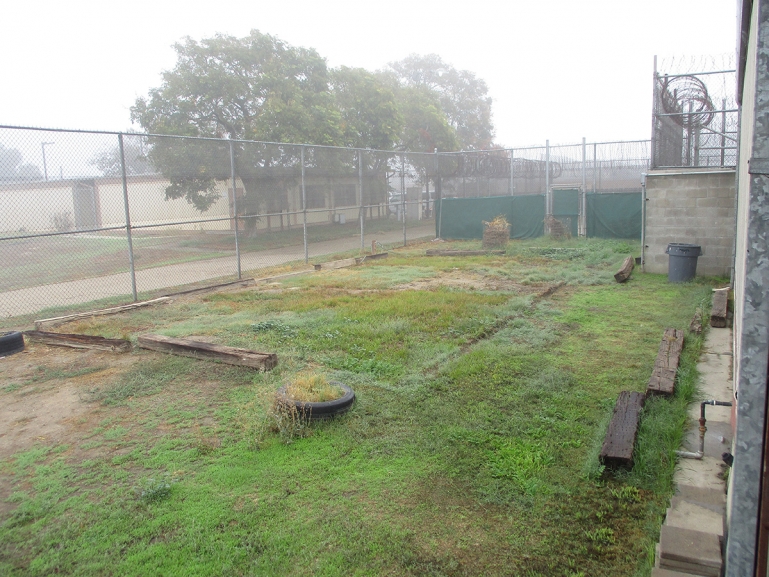 Photo: A section of the yard at KCJC.
Photo: A section of the yard at KCJC.Additionally, youth with disabilities are inevitably harmed by any unnecessary detention or re-detention for probation violations. Harsh enforcement and inadequate community-based service options means that youth with mental and behavioral health needs are found in violation of probation more often than their non-disabled peers. Putting youth, who are already traumatized and at risk of self-harm into repeated detention situations where they are also subject to discipline for disability related behavior (see below) is particularly harmful to this vulnerable population.


Responsibility for these troubling outcomes must fall on Kings County. The County is not responsible for arrests by city police, but it has failed to develop the diversion and reentry programs that would give local police an alternative to arresting troubled youth. County Probation decides which youth to detain. The data shows that youth who pose no threat to public safety are detained at far higher rates than other similar counties and state-wide.6 The County Behavioral Health Department has not developed an effective youth crisis response system or adequate mental health and drug treatment services for youth, with remarkably low service utilization. Needlessly detaining excessive numbers of youth in secure detention is far more costly to Kings County than providing upstream services to support youth in the community.
The CJCJ report details how the Probation Department must “narrow its front door” and “widen its exits” by increasing its crisis services, creating diversion programs at point of arrest, pre- and post-booking, and funding defense based advocacy.7 As we recommend below, The County should assume leadership to bring down these arrest and detention rates by developing, expanding, and coordinating needed community-based services from its agencies. The Probation Department should reconfigure its community-based Probation officers to focus on supporting re-entry and preventing recidivism for justice-involved youth, rather than repeatedly revoking their probation.
Finding 2: Conditions of confinement at the Kings County Youth Detention Center are needlessly punitive and traumatizing to youth.
Under California law, the youth detention center is required to promote rehabilitation in a “safe and supportive homelike environment” for the youth in its custody. See Cal. Welf. & Inst. Code § 851. The Probation Department’s own records and our interviews with youth detained at the facility indicate that instead, the conditions at the detention facility have the effect of punishing, isolating, and intimidating the young people there, while depriving them of crucial educational and rehabilitative opportunities. The facility responds to minor misbehavior and rule violations with escalating sanctions, isolation, and court reports that extend the length of their incarceration. The facility’s harsh response triggers already traumatized youth, who in turn escalate their behavior, making rehabilitation more difficult and increasing overall violence and disruptive conditions. Additionally, youth all reported that food was inadequate in amount, cold, and unappetizing. They reported being constantly hungry, being punished for trying to save or share food with others and asked their interviewers for extra food. This also contributed to a hostile, anxious tone in the facility.


Inadequate Mental Health Care and Unsafe conditions for Youth with Behavioral Disabilities and Trauma
High quality mental health care is critical to the well-being and safety of Kings County youth while they are in custody. Studies estimate that as many as 60% of youth in juvenile detention or correctional facilities have some type of diagnosable mental health and behavioral disability. Our investigation found that the population of youth with mental health and behavioral disabilities in detention is even higher in Kings County then this national average. During our 2022 inspection, mental health staff identified 22 of the 27 youth as needing mental health services, i.e. more than 80% of youth at the detention center.8 Youth involved in juvenile corrections also have much higher levels of post-traumatic stress disorder than non-corrections involved youth. Many youth we interviewed reported a history of trauma and require an environment where they feel safe.
However, our review of incident reports and interviews with youth indicated that the attitudes of staff and the institution itself are harmful and traumatizing to youth with mental health and behavioral disabilities. This manifests in staff-imposed punishment and isolation and inappropriate and excessive use of force (see sections below). Deputies see themselves only as guards; although some might want to act more as counselors, they are not trained to identify and properly communicate and empathize with youth experiencing trauma and other mental health and behavioral disabilities.9 Such staff education and training is critical to the care and well-being of youth in custody.
Most disturbingly, we found evidence that staff as well as peers belittled and bullied youth with disabilities. Youth with intellectual disabilities reported being provoked and degraded by staff, and one disabled youth informed us that staff revealed his alleged offense (a sexual offense) to other youth, which led to harassment and isolation. Staff often failed to stop bullying by peers, stating that this would teach youth how to act properly.10 Our investigation revealed serial punishments meted out to youth with disabilities including isolation and being sent to max. Our investigation also uncovered a failure to provide attainable behavioral plans for youth with disabilities, and a failure to coordinate accommodations for youth in school and custody.
More generally, mental health care in the detention facility is inadequate. Youth complain that they need more individual counseling and cannot wait weeks between appointments. Group counseling is conducted by the same Probation staff who discipline them. Youth report that staff insist they discuss past trauma (not a recommended approach), and if they refuse, they are disciplined for “failure to program.”11 Suicidal ideation is common; staff respond by handcuffing youth and isolating them in a holding cell for long periods until mental health staff are available, which adds to their feelings of despair and isolation.
Overuse of Pepper Spray
Probation staff carry pepper spray at all times just as guards do in adult prisons. Staff routinely use pepper spray to control and subdue detained youth after minimum provocation, including in response to non-violent acts such as talking back, being non-compliant, banging on the inside of a closed cell door,12 or being angry or frustrated. The facility manual directs that custody staff spray youth directly in their face and eyes, a practice that youth confirmed in interviews.13 Our investigation revealed that staff sometimes employ pepper spray on youth who are compliant, have already been subdued, or are otherwise restrained. This use appears to be punitive rather than necessary to protect health and safety. Probation staff also routinely threaten youth with the use of pepper spray, which intimidates youth and contributes to the unsafe atmosphere that pervades the detention facility. Staff’s widespread use of pepper spray to control and intimidate youth creates the impression among youth that they are in constant danger of being sprayed at any time for reasons outside their control.
Pepper spray is very painful and youth should be immediately given chemical wipes to decontaminate. Youth at the detention facility reported no access to decontamination wipes and were often locked in their cells for long periods after an incident without the chance even to shower. Youth reported being so desperate to stop the burning that they dunked their faces in the toilet bowl in their cell.


Probation staff’s frequent use of pepper spray disproportionately affects youth with disabilities. Youth with behavioral, mental health, learning, intellectual and/or developmental disabilities have trouble conforming their behavior to strict rules, such as those at the detention center. They are more likely to be threatened with pepper spray and to be sprayed, and to be targeted by staff based on their disability-related behavior. The frequent use of pepper spray also has detrimental impact on health, particularly for youth and staff with asthma, heart conditions, and other physical and mental health conditions that pepper spray can exacerbate. Youth with disabilities, particularly youth with mental health-related disabilities and a history of trauma, are particularly vulnerable since the experience itself can exacerbate preexisting mental health conditions such as posttraumatic stress disorder. The routine use of pepper spray in the detention facility not only causes physical and psychological harms for the youth it is deployed against, but also undermines attempts to create a more therapeutic environment as required by California law, and contributes to distrust, resentment, and violence.
For this reason, most states across the nation ban the use of pepper spray in juvenile facilities; California is one of only 6 states that permits this. Nearby counties are actively reducing its use and some counties already ban it. The Juvenile Detention Alternatives Initiative (JDAI) has developed standards that are used in more than 300 sites in 39 states, form the basis for federal and state legislation in the juvenile detention realm and have been employed by the U.S. Department of Justice in its investigations. These standards require juvenile justice facilities to strictly prohibit the use of chemical agents like pepper spray.14 Kings County should do the same.
Frequent and Disproportionate Use of Force
The Juvenile Detention Alternative Initiative standards make clear that staff may not use physical force as a form of punishment, and that youth should “feel safe from victimization by staff and youth, including abuse, threats of violence, bullying, theft, sexual abuse, sexual harassment, and assault.”15 Yet, Probation staff routinely use excessive physical force, sometimes “body-slamming” youth to the ground for minor violations such as defiance. Staff also use mechanical restraints such as handcuffs, leg irons, and full body “WRAP” devices to control youth under their care, including youth with disabilities and those experiencing mental health crises. An earlier state inspection revealed that restraints – including leg shackles and the full-body WRAP – were used on youth who posed no threat to themselves, others, or to even to property, and that Probation staff likely undercounted use of force incidents because they were not properly identifying use of restraints as a use of force. Discipline logs show that youth are sometimes placed on “leg-iron status” for days at a time.
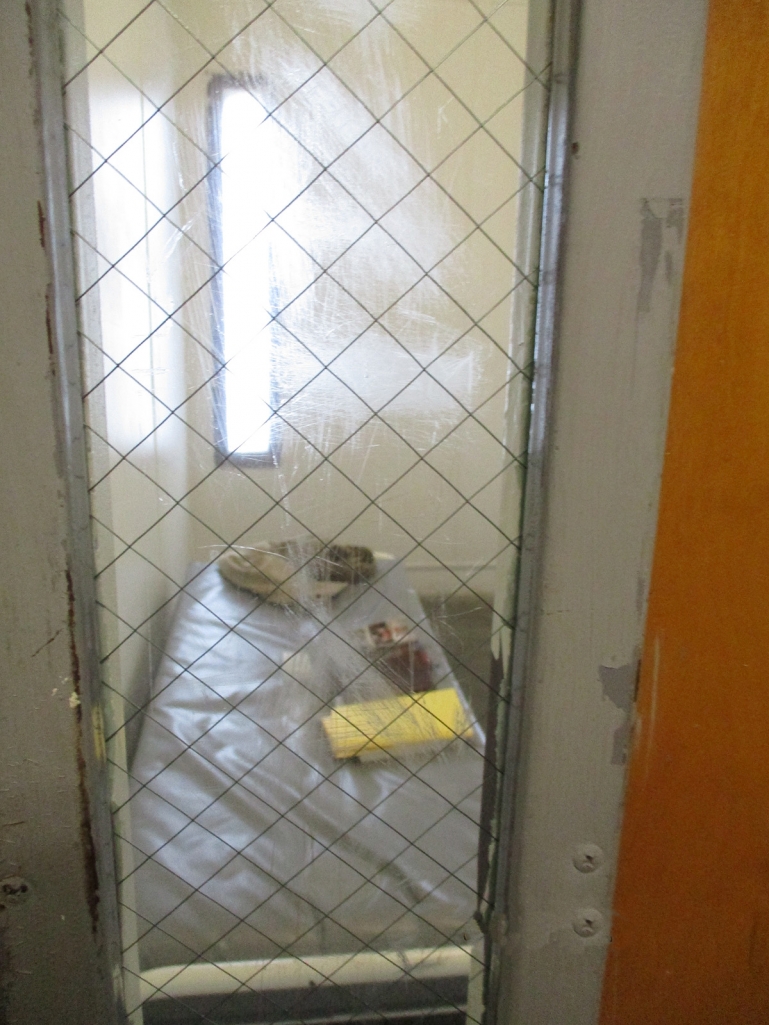 Photo: Another cell at KCJC as seen through the small door window.
Photo: Another cell at KCJC as seen through the small door window.Probation reported roughly two use of force incidents per month for every ten youth detained at the facility – a high rate that includes the use of force in response to self-harming behavior. Youth with behavioral, mental health, learning, intellectual, and/or developmental disabilities are more likely than youth who do not have such disabilities to engage in conduct that precipitates the use of physical force by Probation staff. Further, youth with disabilities, especially youth with mental health-related disabilities and a history of trauma, are particularly vulnerable to the adverse effects of the use of physical force, which can also exacerbate preexisting mental health conditions such as PTSD.
Isolation and “Hallway Status”
State law restricts the use of isolation in juvenile detention facilities and prohibits the use of isolation “for purposes of punishment, coercion, convenience, or retaliation by staff.”16 The state code further prohibits the use of isolation “to the extent that it compromises the mental and physical health of the minor or ward.”17 Despite these restrictions, our investigation revealed that Probation staff at the detention facility punished youth by isolating them from their peers for extended periods of time, including for minor infractions such as speaking during meals or turning their heads while walking. This punishment is called “reassigned seating” or “hallway status” or “hallway assignment”.18
Our review of incident logs indicates that youth are often punished by being made to sit on a hard chair in the hallway outside their cell or in the hall of the unit out of sight of the common room. This appears to be a tactic to get around state law restricting “room confinement” to no more than four hours and not for punitive reasons.19 In the logs, we reviewed youth remaining on hallway status for days. This was not an unusual occurrence, and it was corroborated by interviews with youth. Youth were confined to chairs for a myriad of minimal infractions such as disrespecting staff, talking back, or sharing food. We also were able to corroborate through other documents and interviews with youth that youth with disabilities at the detention facility, especially those with ADHD and mental and behavioral health conditions, are disproportionately punished with hallway status and denied access to program time due to their disability-related behavior.
Furthermore, we found that Probation staff disproportionately use hallway status as isolation to control youth with disabilities, including in response to behavior related to their disabilities instead viewing these youth as “acting out.” Staff do not effectively take youths’ disabilities into account before isolating and segregating them from others or punishing them for behavior; i.e. youth who have a disability are being punished for behavior related to their disability and not within their control. Isolation through either room confinement or hallway status risks exacerbating existing mental health and behavioral conditions and makes it more likely that youth with disabilities subjected to these practices will again engage in disability-related behaviors likely to lead to further punishment. Under Juvenile Detention Initiative guidelines, any isolation of this kind should be used as a last resort and as a temporary response to youth behavior that threatens immediate harm for the youth or others. Kings County does not follow these guidelines.
Prolonged isolation is widely known to have detrimental effects on the physical and psychological well-being of those to whom it is applied.20 Youth on hallway status reported to us that in many ways it is worse than being confined to their cell because they could almost see and could always hear all the other activities that other youth were engaged in – such as video games or movies. Isolation is known to be especially harmful when deployed against youth, leading to heightened risk of suicide and suicide attempts,21 and is even more harmful for those with disabilities.22 Even without the danger to a young person’s mental health, prolonged isolation of youth compromises efforts to rehabilitate them by blocking their access to educational and rehabilitative programming. Furthermore, isolation of youth can undermine and break down trust with adults, resulting in paranoia, anger, and hatred. As a result, youth reintegrating from isolation have difficulty forming the therapeutic relationships necessary to address mental health or behavioral concerns resulting from or exacerbated by the isolation they have experienced.
Additional Probation Issues Identified
Youth also reported that they were denied reasonable and adequate phone calls to family members. They also reported that phone calls were almost always listened in on and the calls were terminated when they tried to talk about conditions in the facility with family members. This silences youth and inflicts greater trauma on them. Listening in on phone conversations violates JDAI standards.
Youth also complained to us in every visit we have made of cold food, small portions and unappetizing food. Youth are punished for sharing food, saving food, or trying to get a second helping.
Lastly, youth reported that the grievance process is inconsistent and that complaints about staff are immediately shared with the staff which then exposes youth to retaliation. Many youth described the grievance system as a “total joke” and feared retaliation. Youth reported disturbing incidents of staff demanding to review grievances before they submitted the grievance.
Finding 3: Kings County fails to meet the general and special education needs of students.
Our observations and those of Dr. Leone confirm that Probation failed to provide adequate resources and interfered with the program at J.C. Montgomery.
First, students are subjected to inappropriate discipline. Probation staff in the classroom, rather than the teacher or aide, look over students’ work on their laptops from the back of the room, and intervene directly if they think a student is not paying sufficient attention. Youth reported that when they try to take a break as permitted by their individual special education plans, Probation staff will reprimand them, write up their behavior in court reports and remove them from the classroom. Unlike most other youth facilities, Probation staff and school staff have no regular process to review incident reports, discuss the needs of various youth, and coordinate supports to disabled youth. Moreover, Dr. Leone found that several youth had behavior support plans that were “tabled” or otherwise ignored at the detention center. A review of incident reports also revealed that Probation staff conduct informal school removals by keeping them on the unit or removing them from the classroom.
 Photo: An interview room at KCJC as seen through the closed door.
Photo: An interview room at KCJC as seen through the closed door.Second, students in the MAX unit are educated in the common room rather than a separate classroom. As this is the day room, other non-student youth may be present and create distractions for students just being present, or in their transit to the bathrooms which are also directly off the common room. Additionally, the station for Probation staff in the unit is in this common room and also distracts students. The MAX unit “classroom” is wholly inadequate for students and especially students with learning disabilities.
Conditions and Practices at the Kings County Juvenile Detention Center Violate State and Federal Law
Youth in detention have important rights and legal protections:
- The 8th and 14th amendments to U.S. Constitution protect youth in detention facilities regarding isolation, use of force, access to educational services and other conditions of confinement.
- Title II of the Americans with Disabilities Act (the ADA), protects people from disability-based discrimination by public entities, which includes the County. 42 U.S.C. § 12132. Section 504 of the Rehabilitation Act of 1973 protects people from disability discrimination in federally funded programs, which also includes the County and the Probation Department. 29 U.S.C. § 794; 28 C.F.R. § 42.503(a), (b). These laws prohibit the County from excluding youth with disabilities from, denying the benefits of, or denying equal access to its programs and services. The Supreme Court has ruled that the ADA requires government to ensure that services are provided in the most integrated setting appropriate to the needs of the disabled individual. See Olmstead v. L.C., 527 U.S. 581 (1999).
- State law also provides protections. California Government Code section 11135 similarly prohibits disability discrimination in state programs. Cal. Welf. & Inst. Code § 851 requires that juvenile detention facilities such as the Kings County Juvenile Center be a “safe and supportive homelike environment” to promote rehabilitation.


The County is ignoring these protections. By disproportionately detaining youth with disabilities and failing to provide adequate community supports, the County is not meeting its obligation to provide services in the most integrated setting for these youth.23 In dealing with youth with disabilities inside the facility, Probation staff disproportionately use excessive chemical and physical force, impose isolation and disciplinary sanctions, and deny them access to education programs and other services provided to non-disabled youth. Probation staff impose these sanctions for disability-related behavior over which youth have no control, and for which they require accommodations, not punishment. Further, these practices exacerbate their disabilities and lead to additional force, isolation, and sanctions. This compounds the detention center’s denial of access to their educational and rehabilitative programs, services, and activities, in violation of state and federal law.
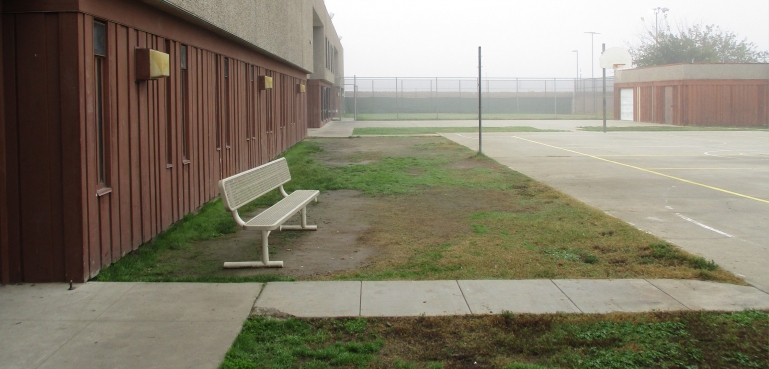
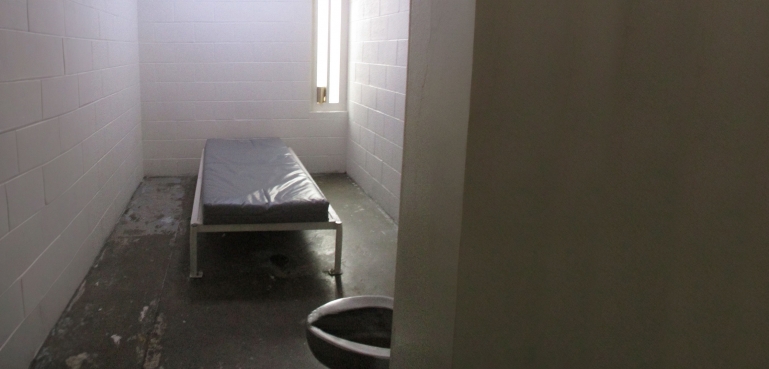
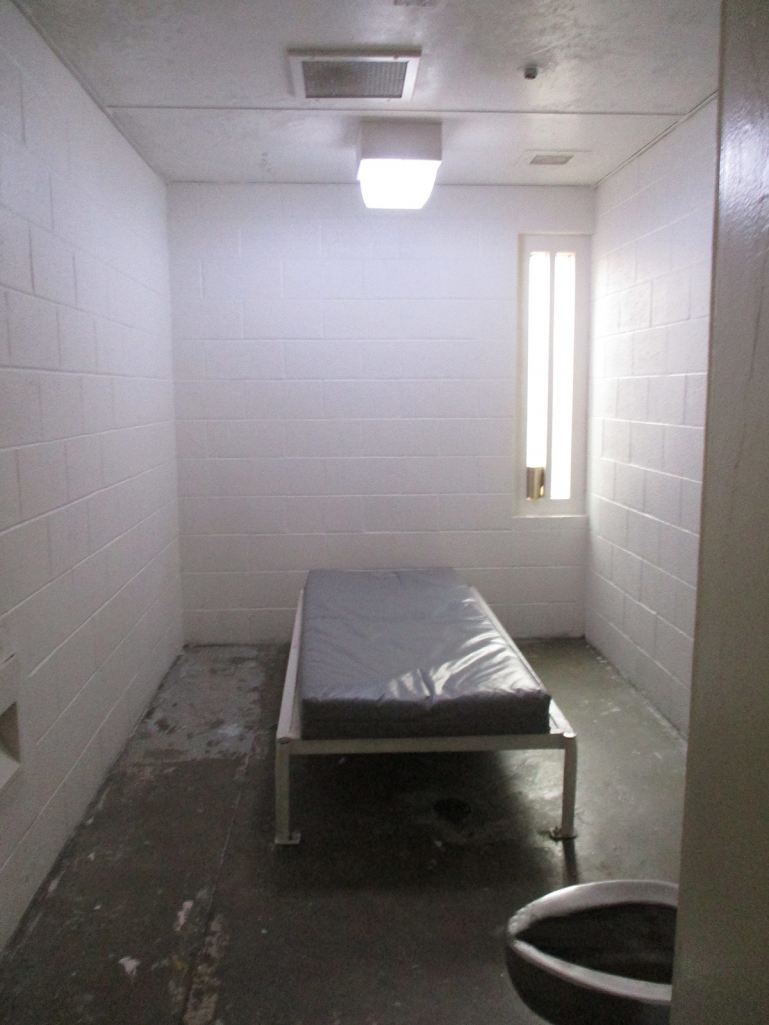
- 1. Status offenses are actions by a minor that would not be a crime if committed by an adult, such as truancy and running away from home.
- 2. Center on Juvenile and Criminal Justice, “Kings County Juvenile Center Investigation Report,” December 2022, page 1 (referred to as “CJCJ Report”).
- 3. Report of the Board of State and Community Corrections, on file with DRC and DRA.
- 4. CJCJ Report at 3-4.
- 5. CJCJ Report at 5. Before the California Division of Juvenile Justice closed its doors, Kings’ commitment rate to state DJJ facilities is more than three times the state average. Presumably this high commitment rate will now apply to the Kings County Juvenile Center.
- 6. CJCJ Report, pages 8-12. Probation’s screening instrument relies heavily on evidence of a prior arrest, which is all too common in this high-arrest rate county. More importantly, Probation has not developed programs for community supervision without the need to first detain youth.
- 7. CJCJ Report, pages 32-35.
- 8. CJCJ Report, page 19.
- 9. CJCJ Report, pages 19-20.
- 10. CJCJ Report, pages 19-20.
- 11. CJCJ Report, pages 21-22.
- 12. Pursuant to a routine inspection, a representative of the California Board of State and Community Corrections reported found that Probation staff inappropriately employed pepper spray into an individual youth’s cell in response to an incident of self-harm.
- 13. The facility’s own records indicate that pepper spray was frequently used in the Max Unit’s classroom, creating additional barriers to education for youth detained there.
- 14. Juv. Detention Alternatives Initiative, Juvenile Detention Facility Assessment – Standards Instrument 2014 Update, 104 (2014), available at http://www.cclp.org/wp-content/uploads/2016/06/JDAI-Detention-Facility-Assessment-Standards.pdf (hereinafter JDAI Assessment Standards (2014)).
- 15. CJCJ Report, pages 25-28.
- 16. Cal. Welf. & Inst. Code § 208.3.
- 17. Id.
- 18. CJCJ Report, pages 16-17.
- 19. Id.
- 20. https://www.vera.org/downloads/publications/the-impacts-of-solitary-confinement.pdf; https://www.ncchc.org/solitary-confinement
- 21. Lindsay M. Hayes, Characteristics of Juvenile Suicides in Confinement, U.S. Dept. of Justice Office of Justice Programs, Office of Juvenile Justice and Delinquency Prevention, Juvenile Justice Bulletin (Feb. 2009), https://www.ncjrs.gov/pdffiles1/ojjdp/214434.pdf; see also Letter from Kenneth Zimmerman, Executive Director & Craig Levine, Senior Counsel & Policy Director, of the New Jersey Institute for Social Justice, et al. to Valerie Edgar, Deputy Attorney General, Special Assistant to the Executive Director, New Jersey Juvenile Justice Commission, 4 (Sept. 16, 2005), http://www.njisj.org/document/testimonyyouthdetention-9-16-05.pdf (citing Lindsay M. Hayes, Juvenile Suicide in Confinement: A National Survey, National Center on Institutions and Alternatives (Feb. 2004), available at https://www.ncjrs.gov/pdffiles1/ojjdp/grants/206354.pdf (urging New Jersey to adopt regulations restricting the use of isolation for juveniles in detention and correctional facilities, in part, because of the substantially increased risk of suicide among youth who are isolated)); see also Lindsay M. Hayes, Juvenile Suicide in Confinement: A National Survey, National Center on Institutions and Alternatives (Feb. 2009), available at https://www.ncjrs.gov/pdffiles1/ojjdp/213691.pdf.
- 22. https://www.aclu.org/sites/default/files/field_document/alone_and_afraid_complete_final.pdf; See, e.g., Rodney A. Ellis, et al., Issues in the Seclusion and Restraint of Juveniles: Policy, Practice and Possibilities, 2 Advances In Social Work 50, 58 (2001) (citing Rodney A. Ellis, et al., Profile-based Intervention: Developing Sensitive Treatment for Adolescent Substance Abusers, 10 Research On Social Work Practice 327 (2000) (describing the negative reactions that youth with psychiatric, intellectual and developmental disabilities often have when they are isolated due to their behaviors and that the professional literature has found that such practices may exacerbate already maladaptive behaviors)).
- 23. See U.S. Dep’t of Just., Investigation of Nevada’s Use of Institutions to Serve Children with Behavioral Health Disabilities (Oct. 4, 2022); Letter from Kristen Clarke, Assist. Att’y General, to Janet Mills, Governor of Maine, re: United States’ Investigation of Maine’s Behavioral Health System for Children Under Title II of the Americans with Disabilities Act (Jun. 22, 2022) (finding that states likely violated integration mandate under Title II of the ADA by failing to provide community-based supports (including crisis intervention services) for youth with mental health disabilities)




